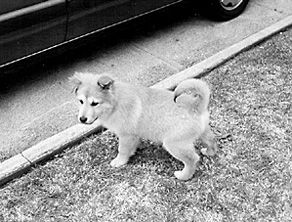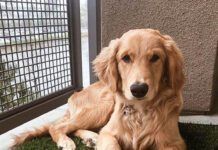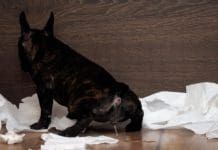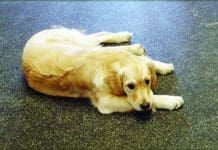The term “housebreaking” grates on my sensibilities like fingernails on a blackboard. What is it that we are supposed to break? This term is deeply rooted in the forced-based philosophy of dog training, and immediately gives new dog and puppy owners the wrong mind-set about the process of teaching their dog to urinate and defecate in appropriate places. We are housetraining, not housebreaking, I gently remind my human students and fellow dog trainers when they slip and use the old-fashioned phrase. Breaking implies punishing the pup for pottying in the wrong spot. Training focuses the client on helping the puppy do it right.
A 3-Step Formula for Training Behavior
Housetraining is simple. You don’t give your puppy the opportunity to make mistakes. You do give him plenty of opportunities to do it right. Simple, however, does not necessarily mean easy. It means making a commitment to manage your pup’s behavior 24 hours a day, until he is old enough to be trusted with his house freedom for increasingly long periods of time.
I teach my clients a basic three-step formula for training or changing a behavior. By applying each of these steps you can get your dog to do just about anything that he is physically and mentally capable of, including housetraining.
Step One: Visualize the behavior you want. Create a mental image of what you want your puppy to do and what that looks like – in this case, to consistently and reliably go the bathroom outside in his designated toilet spot. You need to be able to imagine how this looks in order to be able to train your pup to do it. If you only envision your puppy making mistakes in the house, you won’t have the creativity you need to help him do it right.
Step Two: Prevent him from being rewarded for doing the behavior you don’t want. A reward doesn’t have to come from you in order to be reinforcing to your dog. It is very rewarding to a puppy with a full bowel or bladder to relieve the pressure in his abdomen. If you give him the opportunity to go to the bathroom in the house, that will feel good to him, and he will keep doing it when he has the opportunity. It will eventually become a habit, and then his preference will be to eliminate in the house. Step Two requires you to manage your pup’s behavior so he doesn’t have the opportunity to be self-rewarded by going to the bathroom in the house.
Step Three: Help him do it right and consistently reward him for the behavior you do want. This is the step that often gets skipped. You need to go outside with your puppy and reward him when he performs. If you toss him out in the back yard and don’t go with him, you won’t know if he went to the bathroom or not. Coming back in for a cookie may be more rewarding to him than relieving his bladder, so he waits by the back door, comes in, eats his cookie, and then pees on the rug.
You’ll notice that none of the steps involve punishing the puppy for going to the bathroom in the house. Old-fashioned suggestions like rubbing his nose in his mess or smacking him with a rolled-up newspaper are inappropriate and abusive. They teach your pup to be fearful of relieving himself in your presence, and are very effective at teaching him to pee behind the bed in the guest room where you can’t see and punish him. Besides, it is much easier to teach your puppy to go to the bathroom in one right place than it is to punish him for going to the bathroom in an almost infinite number of wrong places.
If you do “catch him in the act,” simply utter a loud but cheerful “Oops!” and whisk him outside to the proper place. Remember to treat the “oops” spot thoroughly with an enzyme-based cleaner designed to remove all traces of animal waste, such as Nature’s Miracle.
Finally, if you really feel you must make use of that rolled up newspaper, smack yourself in the head three times while repeating, “I will supervise the puppy more closely, I will supervise the puppy more closely, I will supervise the puppy more closely!”
The eight-week house-training program described below is the one that I provide to my clients for an eight-week-old puppy. Many dog owners are amazed by how simple housetraining can be, as well as by the fact that their dogs can be trained to go to the bathroom on cue, in a designated spot.
You will need a properly sized crate; a collar and leash; treats; poop bags; time and patience. A puppy pen, tether, and fenced yard are also useful. (For more information on using these tools, see “Getting Off to the Right Start,” January 1999 and “Tethered to Success,” April 2001.)
If you are starting with an older pup or an adult dog, you may be able to accelerate the timeline, since an older dog is physically able to “hold it” for longer periods than a young pup. If, however, at any point in the program your furry friend starts backsliding, you have progressed too quickly. Back up to the previous week’s lesson.
Effective 8-Week Housetraining Program
Week One: Acclimate your puppy to his crate on his first day in your home, off and on all day (see “Crate Training Made Easy,” WDJ August 2000). While you do this, take him outside on his leash to his designated potty spot every hour on the hour. When he obliges you with a pile or a puddle, tell him “Yes!” in a happy tone of voice (or Click! your clicker), and feed him a piece of cookie.
Pick up his water after 7:00 pm to prevent him from tanking up before bed (later if it is very hot), then crate him when you go to sleep.
Most young puppies crate train easily. The crate should be in your bedroom so your baby dog is not isolated and lonely, and so you can hear him when he wakes up and tells you he has to go out. Do not put him in his crate on the far side of the house. He will feel abandoned and lonely and cry his little heart out, but worse than that, you won’t hear him when he has to go – he will be forced to soil his crate.
A successful housetraining program is dependent on your dog’s natural instincts to keep his den clean. If you force your puppy to soil his crate you break down that inhibition and make it infinitely harder to get him to extend the “clean den” concept to your entire house.
When he cries in the middle of the night, you must get up (quickly), put him on his leash and take him out to his potty spot. Stand and wait. When he starts to go, say “go potty!” or “do it!” or “hurry up!” or whatever verbal cue you ultimately want to use to ask him to go to the bathroom. If you consistently speak this phrase whenever your pup starts to urinate or defecate, you will eventually be able to elicit his urination or defecation, assuming, that is, that he has something to offer you at the moment. Being able to put his bathroom behavior on cue is an added bonus of this method of housetraining, and a very handy one when you’re late for a date, or it’s pouring rain or freezing cold outside!
As soon as your pup has eliminated, tell him “Yes!” in a happy tone of voice and feed him a bit of cookie, praise him, tell him what a wonderful puppy he is, then take him in and put him back in his crate. No food, no play, and no bed-cuddling. If you do anything more than perfunctory potty-performance in the middle of the night he will quickly learn to wake you up and cry for your attention.
First thing in the morning, take him out on leash and repeat the ritual. If you consistently go out with him, on leash, you will teach him to use the designated spot for his bathroom. If you just open the door and push him out, he may well decide that two feet from the back door is far enough, especially if it’s cold or wet out. For the first week or so, if his bladder is too full to make it safely out the door, you can carry him out, but by the end of the second week he should be able to walk to the door under his own power.
Now you can feed your puppy and give him his water bowl, but be sure to keep him right under your nose. If you have to use the bathroom, he goes with you. If you want to sit down to eat breakfast, he’s on his leash under your chair, or tethered by his pillow. Ten to 15 minutes after he is done eating, take him out again, repeat your cue when he does his thing, and Yes!, treat and praise when he is done. Also take him out immediately upon the completion of any exuberant play sessions, and whenever he wakes up from a nap.
For the rest of the day, take him out every hour on the hour for his potty ritual, as well as 10 to 15 minutes after every meal. The remainder of the time he must be under your direct supervision, or on a leash or tether, in his pen or in his crate, every second of the day. Judicious use of closed doors and baby gates can keep him corralled in the room with you, but you still need to watch him. If your puppy starts walking in circles or otherwise looking restless, toss in an extra bathroom break.
“But wait!” you cry. “I work all day, I can’t take him out every hour on the hour.”
Ah, yes, that is why housetraining is simple but not always easy. “Home alone” pups are more likely to end up stuck out in the back yard, where they get left for convenience sake as the housetraining program drops lower and lower on the priority list. If you haven’t yet acquired your pup and you aren’t going to be a stay-at-home Mom or Dad, seriously reconsider the possibility of adopting an older dog who is already housetrained and who may be in desperate need of a home.
If you already have your pup, you will need to either find a skilled and willing puppy daycare provider, or set up a safe, puppy-proofed environment with wall-to-wall newspapers or pee pads, and recognize that your housetraining program will probably proceed more slowly. You cannot crate him for the eight to 10 hours a day that you are gone – you are likely to destroy his den-soiling inhibitions, cause him to hate and fear his crate, and possibly trigger the onset of separation anxiety.
When you are home, be extra diligent about your housetraining protocol, and as your pup starts to show a preference for one corner of his papered area you can start slowly diminishing the size of the covered space. You will eventually have to add the step of teaching him not to go on papers at all, which is one of the reasons many trainers don’t recommend paper training – you are, in essence, teaching him that it is okay to go to the bathroom in the house, and then later telling him that it is not okay.
Week Two: Continue crating your puppy at night. Some pups are sleeping through the night by Week 2. Others need nighttime breaks for a few more weeks. During the day, continue to take him out immediately upon waking, 10-15 minutes after each meal, and after play and naps.
You can now begin teaching him to associate “getting excited” behavior with going out to potty. This will eventually translate into him getting excited to let you know he has to go out. If you want him to do some other specific behavior to tell you he has to go, such as taking a bow, or ringing a bell, start having him do that behavior before you take him out.
By now, you should be able to tell when your puppy is just about to squat in his designated place. Say your “Go pee!” cue just a second or two before he starts, so that your verbal cue begins to precede, rather than follow the behavior.
Stretch his bathroom excursions to 90 minutes apart, and start keeping a daily log – writing down the time, whether he did anything outside, and if so, what he did. Make note of any housetraining mistakes – when and where they occurred. While an occasional “Oops!” may be inevitable (we are only human, after all), if you are having more than one or two accidents a week you are not supervising closely enough or not taking him out enough. The log will help you understand your puppy’s bathroom patterns over the next few weeks, and tell you when you can trust him for longer periods.
Week Three: Crate your puppy at night. (I keep my dogs crated at night until they are at least a year old, and until I am totally confident that they can be trusted to hold their bowels and bladder and keep their puppy teeth to themselves.) During the day, try stretching his bathroom intervals to two hours, still remembering to take him out after all meals, play sessions, and naps.
Continue to keep your log, to make sure your pup’s housetraining program is on track. This is especially helpful for communication purposes if two or more family members are sharing puppy-walking duties.
Also continue to elicit the desired bathroom signal behavior before you take him out, and to use your bathroom cue outdoors, prior to the actual onset of elimination. Over the next few weeks, the verbal cue will begin to actually elicit the behavior, so that you can bring his attention to the business at hand when he is distracted, when you are in a hurry, or when you are in a new place where he isn’t sure he is supposed to pee.
By the end of this week, your puppy should be leading you on his leash to the bathroom spot. Look for this behavior as an indication that he is making the connection to the spot that you want him to use.
Week Four: Crate your puppy at night. Assuming all is going well, stretch daytime intervals to three hours, plus meal, play and nap trips. Go with him to his fenced-yard bathroom spot off-leash, to confirm that he is going there on his own, without you having to lead him. Continue to keep your daily log, and reinforce your “outside” and “bathroom” cues.
Weeks Five-Eight: Keep crating your puppy at night. Gradually increase the time between bathroom breaks to a maximum of four hours, plus meals, play, and naptime. You still need to go out with him most of the time, but you can occasionally send him out to his bathroom spot in his fenced yard all on his own, watching through the door or window to be sure he goes to his spot and gets the job done. By this time, accidents in the house should be virtually nonexistent. As long as the program is progressing well, you can begin phasing out your daily log. As your pup continues to mature over the next eight months, he will eventually be able to be alone left for up to eight hours at a time, perhaps slightly longer.
At that point, you can break out the champagne and celebrate – you and your puppy have come of age!
Housetraining Tips and Reminders
1. If your housetraining-program-in-progress relapses, back up a week or two in the process and keep working from there. If that doesn’t resolve the problem promptly (within a day), a trip to the vet is in order, to determine if there is a medical problem, such as a urinary tract infection, that is making it impossible for your puppy to hold it. The longer you wait, the more ground you have to make up.
2. If your pup has diarrhea, not only is it impossible for him to comply with housetraining, he may also be seriously ill. Puppies can dehydrate to a life-threatening degree very quickly. Contact your veterinarian immediately.
3. If your-paper-trained pup refuses to go on anything other than paper, take a sheet of newspaper or pee pad outside and have him go on that. Each subsequent trip, reduce the size of the fresh sheet of paper or pad until it is gone.
4. If your dog’s inhibitions against soiling his den have already been damaged, you may need to remove his bedding from his crate – it is possible that this is now his preferred substrate. Try the bare crate floor or a coated metal grate instead, and set your alarm to wake you up at night as often as necessary to enable you to consistently take him out before he soils his crate.
5. Neutering your male dog between the ages of eight weeks and six months will minimize the development of assertive territorial leg-lifting. Already existing territorial leg-lifting can be discouraged as part of a complete housetraining program with the use of “Doggie Wraps,” a belly band made for this purpose (available from pet supply stores and catalogs).
6. If at any time your reliably housetrained dog begins having accidents in the house, have him examined by your veterinarian in case there is a physical cause.
7. Remember that drugs such as Prednisone can cause increased water intake, which causes increased urination. If it is not a medical problem, evaluate possible stress factors and return to a basic housetraining program.
8. Vigorous exercise can also cause excessive water intake and subsequent urination, as can a medical condition known as polydipsea/polyurea, which simply means drinking and urinating too much.
9. When your dog has learned to eliminate on cue, start asking him to poop and pee on various surfaces, including grass, gravel, cement, and dirt. Dogs can easily develop a substrate preference – grass, for example – and may refuse to go to the bathroom on anything but their preferred surface. If you are ever in a location where there is no grass, you and your dog could be in trouble.
10. If your situation is such that your pup must constantly be asked to wait to go for longer periods than is reasonable, consider litter box training. Lots of people do this, especially those with small dogs and those who live in highrise apartments. This also resolves the substrate-preference problem.







My dog has irregular eating so subsequently so is her potty training. She s 9 months and has learned to run in another room to dedicate.(just started this) we live in two locations with different layouts. She great with demand training. She hates going out in the rain or snow covered ground. She was great in the summer because she was on first level and was easier to watch her movements ( what to do with this learned behavior)
Pompous. I’ll pass on this website.